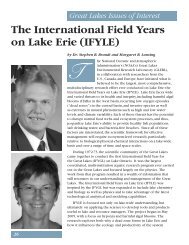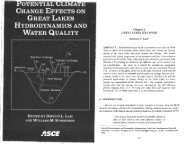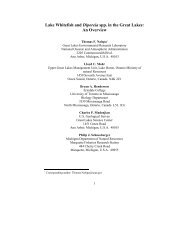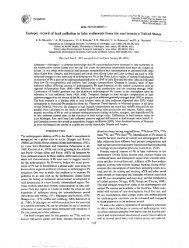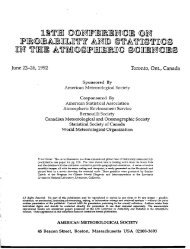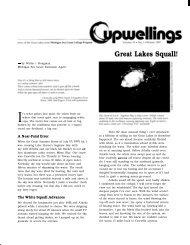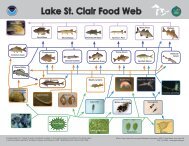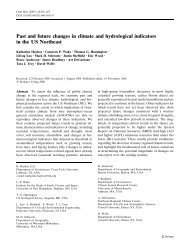Phosphorus limitation and diel control of nitrogen-fixing ...
Phosphorus limitation and diel control of nitrogen-fixing ...
Phosphorus limitation and diel control of nitrogen-fixing ...
You also want an ePaper? Increase the reach of your titles
YUMPU automatically turns print PDFs into web optimized ePapers that Google loves.
46<br />
Mar Ecol Prog Ser 345: 41–50, 2007<br />
NfixP – NfixC (% NfixC)<br />
ChlP – ChlC (% ChlC)<br />
[% <strong>control</strong>]) represents the new activity or growth that<br />
occurred in response to P. There was a significant<br />
positive relationship (linear regression) between time<br />
<strong>and</strong> the ‘new N 2 fixation’ (R 2 = 0.54, p = 0.000) <strong>and</strong><br />
‘new chl a’ (R 2 = 0.79, p = 0.000) (Fig. 3). Cyanobacterial<br />
numbers <strong>of</strong> all taxa (N. spumigena, Aphanizomenon<br />
sp., Anabaena spp.) increased during the <strong>diel</strong> experiment<br />
that had a 64 h pre-incubation with P (Fig. 4).<br />
Very calm, sunny conditions prevailed during<br />
the anchor station experiment in 2003 (An03) (Fig. 5).<br />
Aphanizomenon sp. was the only diazotroph detected<br />
in microscopic observations at this station. Nitrogen<br />
fixation continued at both 1 <strong>and</strong> 8 m depths throughout<br />
the <strong>diel</strong> cycle (Fig. 5A), <strong>and</strong> trailed the irradiance<br />
intensity in the water column <strong>and</strong> air (Fig. 5A,B). There<br />
was a deepening <strong>of</strong> the thermocline during the day<br />
<strong>and</strong> gradual shallowing again at night (Fig. 5C).<br />
The Fe protein was detected throughout the <strong>diel</strong><br />
cycle in both the Cubitainers <strong>and</strong> the anchor station<br />
experiment (Fig. 6). No changes over the <strong>diel</strong> cycle in<br />
molecular weight (MW) or consistent changes in<br />
the abundance <strong>of</strong> the <strong>nitrogen</strong>ase Fe protein in<br />
immunoblots were observed either in the Cubitainer<br />
incubations or samples taken directly from the sea<br />
(Fig. 5). A second, higher MW b<strong>and</strong> appeared sporadically<br />
in an experiment in which inhibitors were tested<br />
(data not shown). In the Baltic Sea field samples, the<br />
MoFe protein had a very weak antibody binding<br />
capacity <strong>and</strong> blots did not produce good results.<br />
350<br />
300<br />
250<br />
200<br />
150<br />
100<br />
50<br />
0<br />
–50<br />
–100<br />
70<br />
60<br />
50<br />
40<br />
30<br />
20<br />
10<br />
0<br />
–10<br />
–20<br />
A<br />
B<br />
y = 1.869x – 40.937<br />
2 R = 0.536<br />
y = 0.585x – 13.805<br />
2 R = 0.7925<br />
20 40 60 80 100 120<br />
Time (h)<br />
Fig. 3. Linear regression between (A) ‘new N 2 fixation’ <strong>and</strong><br />
time; <strong>and</strong> (B) ‘new chl a’ <strong>and</strong> time, in response to P. Data from<br />
4 enrichment experiments were pooled; y-axis unit is the difference<br />
between P treatment (suffix P) <strong>and</strong> <strong>control</strong> (suffix C)<br />
(% <strong>of</strong> <strong>control</strong>)<br />
100 µm filament fragments ml –1<br />
700<br />
600<br />
500<br />
400<br />
300<br />
200<br />
100<br />
0<br />
Nod Aph Ana<br />
A culture experiment was carried out with a Nodularia<br />
spumigena strain to investigate its <strong>diel</strong> cycle in N 2<br />
<strong>and</strong> CO 2 fixation <strong>and</strong> abundances <strong>and</strong> motility <strong>of</strong> <strong>nitrogen</strong>ase<br />
proteins, in order to compare these with the<br />
field data (Fig. 7). Carbon fixation was tightly coupled<br />
with light, while N 2 fixation continued throughout the<br />
<strong>diel</strong> cycle, albeit at reduced rates in the dark. The<br />
N 2 fixation rates in the dark were 21 to 45% <strong>of</strong><br />
maximum rates in the light. Both Fe <strong>and</strong> MoFe proteins<br />
remained present throughout the <strong>diel</strong> cycle, with no<br />
detectable changes in abundance or MW. The MoFe<br />
protein from N. spumigena cultures had a weak<br />
binding capacity with the antibody <strong>and</strong> resolved as<br />
3 b<strong>and</strong>s, while the MoFe protein from Anabaena<br />
aphanizomenoides <strong>and</strong> Anabaenopsis sp. (both isolated<br />
from the Neuse River Estuary, North Carolina)<br />
resolved as 2 b<strong>and</strong>s <strong>and</strong> had a much stronger binding<br />
capacity with the antibody (data not shown). DIC concentration<br />
gradually decreased during the day, but by<br />
the following morning had returned to the same level<br />
as the morning before.<br />
DISCUSSION<br />
No P<br />
P<br />
Fig. 4. Nodularia spumigena (Nod), Aphanizomenon sp.<br />
(Aph) <strong>and</strong> Anabaena spp. (Ana). Abundances <strong>of</strong> diazotrophic<br />
cyanobacteria at the end <strong>of</strong> <strong>diel</strong> Expt 03B. No P: <strong>control</strong><br />
treatment; P: P added<br />
The phosphorus effect on N 2 fixation <strong>and</strong> chl a was<br />
striking <strong>and</strong> consistent in <strong>diel</strong> experiments that started<br />
64 <strong>and</strong> 88 h after the P addition (Expts 03B <strong>and</strong><br />
02B, respectively). When all the data were pooled, it<br />
became apparent that P started to affect the population<br />
growth <strong>and</strong> N 2 fixation rates earlier than 64 h <strong>of</strong> P addition<br />
(Fig. 3). Chl a concentrations <strong>and</strong> cyanobacterial<br />
numbers paralleled N 2 fixation rates; therefore, it was<br />
not clear whether P stimulated growth, N 2 fixation, or<br />
both. Potentially, P could directly enhance <strong>nitrogen</strong>ase<br />
gene mRNA copy numbers <strong>and</strong> consequently N 2 fixa-



